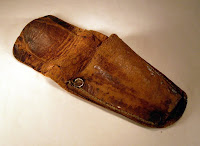 Here's a simple yet decorative zipper pull you can make with paracord. It might also be used as a key or watch fob, even as a knife lanyard.
Here's a simple yet decorative zipper pull you can make with paracord. It might also be used as a key or watch fob, even as a knife lanyard.It begins as a bend (a bend joins two ropes together) called the Japanese Bend in The Ashley Book of Knots (ABOK 1423) but easily becomes a zipper pull by modifying it to use only one working end.
This is how the Japanese Bend appears in the ABOK:
 But before you see how to tie it as a zipper pull, first try it as a bend so you get the hang of it. Start with two strands of cord or use the two ends of one piece. Click the picture below and start your knot, working the cord till you get it to look like the completed bend.
But before you see how to tie it as a zipper pull, first try it as a bend so you get the hang of it. Start with two strands of cord or use the two ends of one piece. Click the picture below and start your knot, working the cord till you get it to look like the completed bend.
(By the way, don't bother to add the Japanese Bend to your arsenal of real-world, working bends - it's only worthwhile as a decoration.)
After you've got the bend figured out, try the modification for a zipper pull.Start with the end of one long strand - you'll want to work with at least 2 feet - but it could be any length because you're not going to cut the cord until you're all done and have worked it down to the size you want.
My modification is to create the zipper pull loop by making the working end of the bottom strand (in Ashley's diagram) longer and bringing it around to use it as the other strand in the bend. See the picture below.
 So that's it but it's not really necessary that you understand it. Just use the picture below to start your zipper pull and work your cord till it's the size you want. Then cut and melt the end.
So that's it but it's not really necessary that you understand it. Just use the picture below to start your zipper pull and work your cord till it's the size you want. Then cut and melt the end.
I attached one to my carhartt winter coat.
Once you make a few of these, you'll see how simple they really are. Last night I had a 20 foot length of paracord and I made one, cut it off, then made another, cut it off... until I made the 4 pictured at the top. So there's no waste. And if you were to pull one of those apart, you'd see it was only about 11 1/2" long. So it doesn't use much cord.
Sometimes I'll make up a handful of these while I'm watching TV, carry them around and hand them out to people I meet. If you carry a piece of paracord with you, you can make one on-the-spot then give it away - it's like performing a magic trick.
I also have zipper pulls on my website HERE.
I hope you like this. Have some fun.






















































